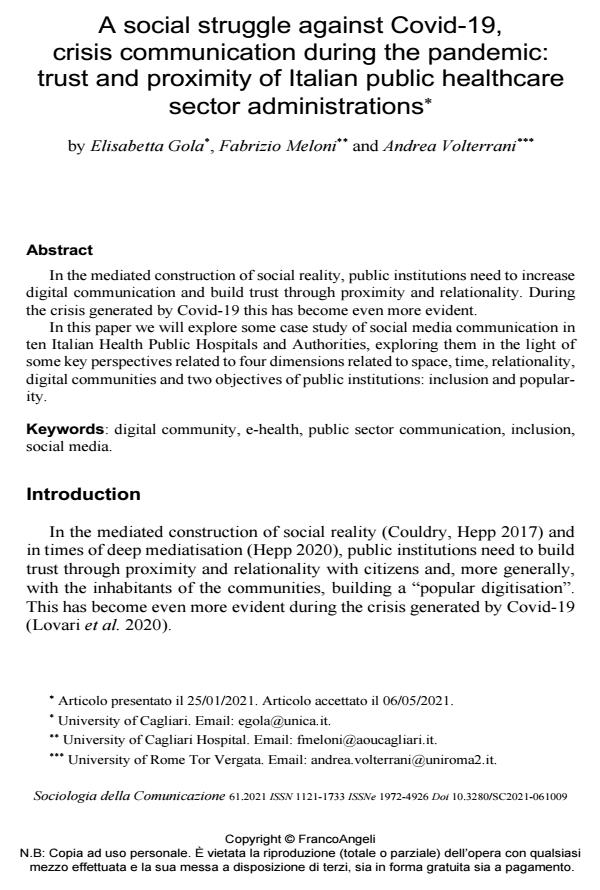A social struggle against Covid-19, crisis communication during the pandemic: trust and proximity of Italian public healthcare sector administrations
Journal title SOCIOLOGIA DELLA COMUNICAZIONE
Author/s Elisabetta Gola, Fabrizio Meloni, Andrea Volterrani
Publishing Year 2021 Issue 2021/61 Language English
Pages 19 P. 127-145 File size 615 KB
DOI 10.3280/SC2021-061009
DOI is like a bar code for intellectual property: to have more infomation
click here
Below, you can see the article first page
If you want to buy this article in PDF format, you can do it, following the instructions to buy download credits

FrancoAngeli is member of Publishers International Linking Association, Inc (PILA), a not-for-profit association which run the CrossRef service enabling links to and from online scholarly content.
In the mediated construction of social reality, public institutions need to in-crease digital communication and build trust through proximity and relationality. During the crisis generated by Covid-19 this has become even more evident. In this paper we will explore some case study of social media communication in ten Italian Health Public Hospitals and Authorities, exploring them in the light of some key perspectives related to four dimensions related to space, time, relational-ity, digital communities and two objectives of public institutions: inclusion and popularity.
Keywords: digital community, e-health, public sector communication, inclusion, social media.
- Andreula N. (2020), #Phygital. Il nuovo marketing tra fisico e digitale, Hoepli, Torino.
- Zamani E.D. (2018), Social inclusion and ICTs. A literature review through the lens of capability approach, in Choudrie J., Kurnia S., Tsatsou P. (eds.) Social Inclusion and Usability of ICT-enabled Services, Routledge, New York, pp.11-29.
- Wolf M. (1985), Teorie delle comunicazioni di massa, Bompiani, Milano.
- Van Djiek J., Poell T., De Waal M. (2018), The platform society: Public values in a connective world, Oxford University Press, Oxford.
- Tsatsou P. (2011), Digital Divides in Europe: Culture, Politics and the Western-Southern Divide, Peter Lang Pub Inc., New York.
- Sen A. (1985), Commodities and capabilities, Elsevier, Amsterdam.
- Rosa H. (2013), Social Acceleration: A New Theory of Modernity, Columbia University Press, New York.
- Lovari A., D’Ambrosi, L., Bowen S.A. (2020), Re-Connecting Voices. The (New) Strategic Role of Public Sector Communication After the Covid-19 Crisis, in «Special Issue PACO», V. 13, N. 2,
- Lovari A. (2017), Social media e comunicazione della salute. Profili istituzionali e pratiche digitali, Guerini, Milano.
- Kozinet R. (2019), Netnography: The Essential Guide to Qualitative Social Media Research, SAGE , Los Angeles.
- Iyengar K, Jain VK, Vaishya R. (2020), Pitfalls in telemedicine consultations in the era of COVID 19 and how to avoid them, in «Diabetes Metab Syndr». 2020 Sep-Oct;14(5):797-799.
- Hepp A., Krotz F. (eds) (2014), Mediatized worlds. Culture and society in a media age, Palgrave MacMillan, Hampshire.
- Hepp A. (2015), Transcultural communication, Wiley-Balckwell, Malden (MA).
- Hepp A (2020), Deep Mediatization, Routledge, London.
- Ervas F., Gola E., Rossi M.G. (2015), Metaphors and Emotions as Framing Strategies in Argumentation, in G. Airenti, B. Bara, G. Sandini (eds.), Proceedings of the EuroAsianPacific Joint Conference on Cognitive Science, CEUR, Torino, pp. 645-650.
- Elawady A., Khalil A., Assaf O., Toure S., Cassidy C. (2020), Telemedicine during COVID-19: a survey of Health Care Professionals' perceptions, in «Monaldi Arch Chest Dis», 22;90(4).
- Dunbar R. I. (2011), How many friends does one person need?: Dunbar’s number and other evolutionary quirks, Faber and Faber, London.
- Couldry N. (2012), Media, society, world: Social theory and digital media practice, Polity Press, Cambridge.
- Couldry N., Mejias U. (2019), The cost of connection. How data is colonizing human life and appropriating it for capitalism, Stanford University Press, Stanford.
- Couldry N., Hepp A. (2017), The mediated construction of reality, Polity Press, Cambridge.
- Couldry N. (2004), Theorising media as practice, in «Social Semiotics», n. 14, pp. 115-132, DOI: 10.1080/1035033042000238295
- Cijan A., Jenic L., Lamovšek A., Stemberger J. (2019), How digitalization changes the workplace, in «Dynamic Relationships Management Journal», Vol. 8, No. 1. May, pp. 3-12,
- Choudrie J., Tsatsou P., Kurnia S. (2018) (eds), Social Inclusion and Usability of ICT-Enabled Services, Routledge, New York.
- Carlo S., Boccia Artieri G., Pasquali F., Pedroni M. (2017), Fenomenologia dei social network. Presenza, relazioni e consumi mediali degli italiani, Guerini Scientifica, Milano.
Elisabetta Gola, Fabrizio Meloni, Andrea Volterrani, A social struggle against Covid-19, crisis communication during the pandemic: trust and proximity of Italian public healthcare sector administrations in "SOCIOLOGIA DELLA COMUNICAZIONE " 61/2021, pp 127-145, DOI: 10.3280/SC2021-061009